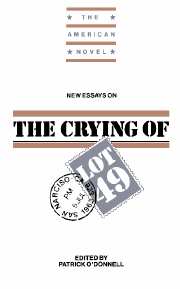Book contents
- Frontmatter
- Contents
- Series Editor's Preface
- 1 Introduction
- 2 Borges and Pynchon: The Tenuous Symmetries of Art
- 3 Toward the Schizo-Text: Paranoia as Semiotic Regime in The Crying of Lot 49
- 4 “Hushing Sick Transmissions”: Disrupting Story in The Crying of Lot 49
- 5 “A Metaphor of God Knew How Many Parts”: The Engine that Drives The Crying of Lot 49
- 6 A Re-cognition of Her Errand into the Wilderness
- Notes on Contributors
- Selected Bibliography
5 - “A Metaphor of God Knew How Many Parts”: The Engine that Drives The Crying of Lot 49
Published online by Cambridge University Press: 12 January 2010
- Frontmatter
- Contents
- Series Editor's Preface
- 1 Introduction
- 2 Borges and Pynchon: The Tenuous Symmetries of Art
- 3 Toward the Schizo-Text: Paranoia as Semiotic Regime in The Crying of Lot 49
- 4 “Hushing Sick Transmissions”: Disrupting Story in The Crying of Lot 49
- 5 “A Metaphor of God Knew How Many Parts”: The Engine that Drives The Crying of Lot 49
- 6 A Re-cognition of Her Errand into the Wilderness
- Notes on Contributors
- Selected Bibliography
Summary
Nearly everyone who has written about The Crying of Lot 49 has commented on the ambiguous ending. A sense of mystery or irresolution hangs over the novel even after one has read and reread it many times. Many readers take the lingering ambiguities to signal that The Crying of Lot 49 is a postmodern text, more interested in revealing the constructed nature of consensual reality than in mimetically reflecting a world that exists independent of our perceptions. Yet as the novel draws to a close there is also a growing sense of limitation, as if Oedipa were coming up against irreducible constraints that limit interpretation and circumscribe action. It may be, then, that the underlying ambiguity of the novel rests between a postmodern view that renders irrelevant the distinctions between life and art, and a realism that reaches beyond construction toward a reality that exists whether or not we apprehend it.
The challenge is to understand how such an ambiguity can be constructed and maintained in a work which exists as a verbal construction, acknowledges itself as such, and yet points beyond to something outside the realm of language. My approach will be through metaphor. To say that something is metaphoric is to imply that it is not literal but a similitude constructed through language.
- Type
- Chapter
- Information
- New Essays on The Crying of Lot 49 , pp. 97 - 126Publisher: Cambridge University PressPrint publication year: 1992
- 1
- Cited by



